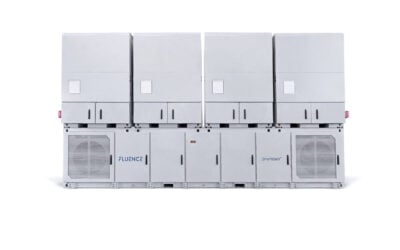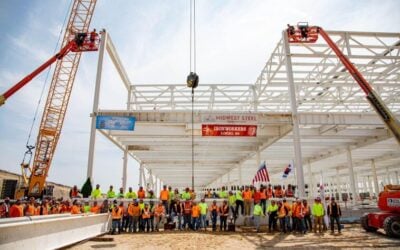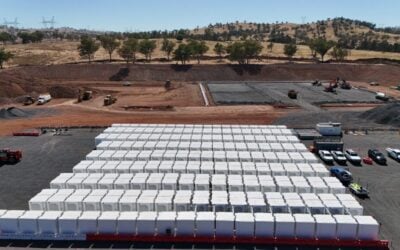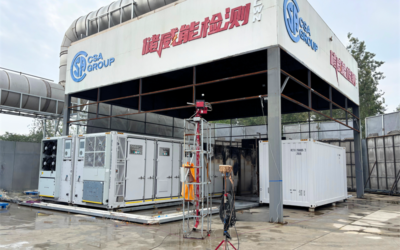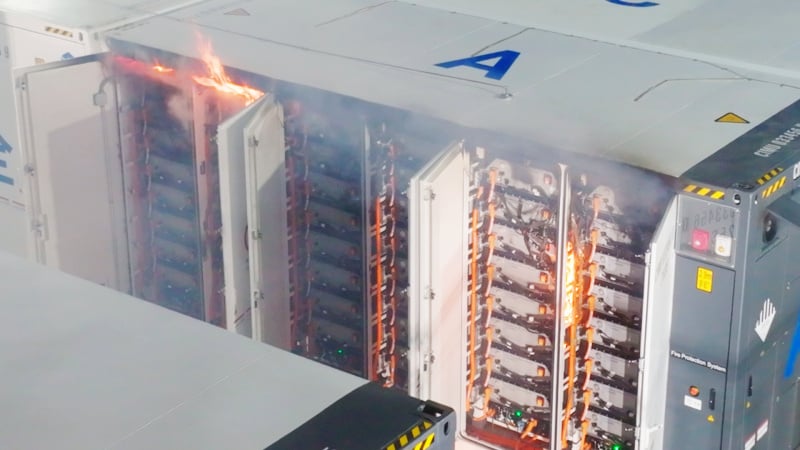
A trio of major players in the battery storage system integration space have unveiled recent Large-Scale Fire Testing (LSFT) results.
Hithium, Canadian Solar, and Fluence have all announced the latest LSFT procedures carried out on their battery energy storage system (BESS) equipment. Each reported that no propagation occurred from the units lit on fire and allowed to burn to neighbouring units.
Large-scale fire testing is becoming an increasingly commonplace best practice for BESS technology providers. It is designed to replicate as closely as possible what equipment in the field might experience in worst-case scenarios.
Basically, while BESS equipment these days typically comes with several layers of fire detection and suppression features, in LSFT, a unit is set on fire with all its fire prevention and mitigation functions switched off and allowed to burn.
Try Premium for just $1
- Full premium access for the first month at only $1
- Converts to an annual rate after 30 days unless cancelled
- Cancel anytime during the trial period
Premium Benefits
- Expert industry analysis and interviews
- Digital access to PV Tech Power journal
- Exclusive event discounts
Or get the full Premium subscription right away
Or continue reading this article for free
In November last year, standards development, testing and certification company CSA Group partnered with Energy-Storage.news to sponsor the free webinar, ‘Evolving large-scale fire testing requirements for battery energy storage systems,’ in which experts explained the purpose, scope and methodology of the latest LSFT procedures.
In the webinar, CSA Group global business director for energy & power, Michael Becker, said that manufacturers and authorities having jurisdiction (AHJs) had requested the development of a test protocol for large-scale fires at BESS installations.
LSFT is set to become a mandatory requirement with the forthcoming 2026 edition of the National Fire Protection Association (NFPA) NFPA 855 standard for storage systems.
CSA Group works with Fluence, Canadian Solar
According to announcements from both companies, CSA Group witnessed and verified the results of Canadian Solar and Fluence’s most recent tests.
Canadian Solar’s e-STORAGE Solbank 3.0
In early June, Canadian Solar said the SolBank 3.0 BESS solution, which is manufactured through the e-STORAGE brand of the vertically integrated solar PV and energy storage company’s CSI Solar manufacturing subsidiary, underwent the CSA C-800:25 §9.7 Large-Scale Fire Testing (LSFT) protocol.
“Key stakeholders in the energy storage industry have raised justifiable concerns about the ability of BESS to limit the spread of fire between units without relying on complex extinguishing systems or putting first responders at risk,” CSA Group fire test specialist Joshua Dinaburg said.
Flames were contained to the Solbank 3.0 enclosure set on fire, without propagation to adjacent enclosures. Doors, louvers and structural elements of target enclosures remained closed and intact throughout the test.
Along with CSA Group, BESS fire safety specialist Energy Safety Response Group (ESRG) also witnessed and verified the test.
“The e-STORAGE system demonstrated that an aggressive fire consuming all available fuel in one unit does not ignite new fires and spread to adjacent units,” Joshua Dinaburg said.
“This is critical performance data for the end-users and site managers, first responders, insurance adjusters, and the community at large where these systems may be installed.”
Fluence Gridstack Pro 5000
Last week, Fluence said it had carried out tests of its Gridstack Pro 5000 BESS unit, including explosion and fire testing.
The BESS technology provider did not specifically refer to the CSA C-800:25 §9.7 Large-Scale Fire Testing (LSFT) protocol in its announcement on 13 June. It did, however, mention that CSA Group observed the tests and that the tests “far exceeded” current UL9540A thermal runaway testing requirements and were aligned with NFPA 855 requirements.
Tests on the 5.6MWh 20-foot BESS enclosure were carried out at SAFE Labs in North Carolina, US, including five days of explosion testing prior to fire testing.
Explosion testing included two days of dispersion testing—during which active ventilation systems in the unit enabled the effective exhaustion of gases, which would prevent the buildup of flammable gases, in line with the NFPA 69 standard—while all six of the unit’s deflagration panels deployed as intended during three days of deflagration testing, in line with NFPA 68 requirements.
In the fire testing, four Gridstack Pro 5000 enclosures equipped with live batteries were arranged with minimum spacing, with the centre unit set on fire. No propagation to adjacent enclosures occurred. Battery cells in the three units that were not on fire remained within safe limits, Fluence said.
“This testing goes far beyond what the industry currently requires and is not only a validation of our design, but a real-world demonstration of how next-generation systems must perform under worst-case scenarios,” Fluence chief product and supply chain officer Peter Williamson said.
During testing, Fluence also collected gas sampling data, which the company claimed would help support various stakeholders in aspects such as plume analysis, emergency response training and permitting guidance.
‘All open-door’ test for Hithium
Meanwhile, Hithium claimed a ‘world-first’ a couple of weeks ago, with the announcement that it had conducted LSFT with all the doors of its ∞Block 5MWh container open.
The Chinese battery storage company claimed the test’s atypical design would set a new benchmark for safety validation in the industry.
Again, four containers were set up spaced just 15cm apart, with the batteries inside all fully charged to 100% state of charge (SoC), and one unit was then set on fire.
Hithium said that despite 15 hours of full combustion and temperatures reaching 1300°C, the structure of the unit set alight remained fully intact, and the fire did not spread to neighbouring units.
UL Solutions conducted Hithium’s testing, which was witnessed by certified US fire protection engineers and Hithium customers.
Other notable reports of LSFT from various battery storage players since late last year include Wärtsilä being among the first to carry out the testing under CSA’s new protocol designed to imitate real-world worst-case scenarios, and Sungrow live-streaming a four unit burn test for selected customers, experts and project stakeholders.

